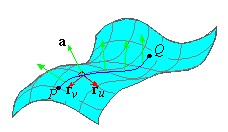DIFF GEOM: Geodesics
The material in this chapter brings us very close to an extremely important
field of mathematics known as Differential Geometry. The "DIFF
GEOM" material at the end of this chapter and in a few places in chapter 5
comprises an introduction to this extremely important field. The
"DIFF GEOM" material may be omitted completely without compromising
the course, but we felt that such proximity to this important body of
mathematics justified including this material for those inclined to pursue it.
Let's begin with the concept of a geodesic. Suppose that r( u,v) is the parameterization of a
surface and that r( t) = r( u(t) ,v( t) ) is a
curve on that surface. If the acceleration r'' (t) is normal to the surface at each point
on the curve, then r( t) is said to be a geodesic
on r( u,v).
Equivalently, r( t) = r( u(t) ,v( t) ) is a geodesic only if r'' · ru = 0 and r'' · rv = 0. That is, a geodesic does not curve in any tangent
plane to the surface, which means that geodesics are the ''straightest''
curves on a surface. The concept of a geodesic is illustrated by the animation below:
Clicking on the animation will switch to a different view.
EXAMPLE 1 Let r( u,v) =
á cos( u) ,sin( u) ,v
ñ be a parameterization
of the right circular cylinder, and let r( t) = r( t,2t+1) be a curve on that surface. Show that r( t) is a geodesic on the cylinder.
Solution: The expression r( t,2t+1) implies
that u = t and v = 2t+1. Thus, r( t) =
ácos( t) ,sin( t) ,2t+1
ñ , so that
|
r' ( t) =
á -sin( t),cos( t) ,2
ñ and
r''( t) =
á -cos( t),-sin( t) ,0
ñ |
|
Since ru =
á -sin( u) ,cos(u) ,0
ñ and rv =
á0,0,1
ñ and since u = t, we have
|
|
|
|
cos( t)sin( u) -cos( u) sin( t) |
| |
|
|
cos( t) sin( t) -cos( t) sin( t) |
| |
|
|
|
Likewise, r'' · rv = 0·cos( t) -0·sin( t) +2·0 = 0. Thus, r( t) = r( t, 2t+1) is a geodesic on the
cylinder.
In general, the geodesics on the plane are straight lines, and the
geodesics on the right circular cylinder parameterized by
|
r( u,v) =
á cos( u) ,sin(u) ,v
ñ |
|
are the images of the straight lines after the plane has been
rolled up into a cylinder-i.e.,
circles, vertical lines, and helices that are curves of the form
where a, b, c, and d are constants.
In fact, if a surface r( u,v) contains a straight
line L( t) = mt+b, then L¢( t) = m and L¢¢( t) = 0. Thus, L¢¢· ru = 0 and L¢¢· rv = 0, which
implies that any straight line contained within a surface must be a
geodesic of the surface.
EXAMPLE 2 Show that the catenoid x2+y2-z2 = 1 can be
parameterized by
|
r( u,v) =
á cos(v)-usin( v),sin( v) +ucos( v) ,u
ñ , u in ( -¥,¥) , v in [ 0,2p] |
|
and then show that g( t) = r(t,q) is a straight line for each fixed value of q in [ 0,2p] .
Solution: Since x = cos( v) -usin( v)
and y = sin( v) +ucos( v) , we have
|
|
|
|
( cos( v) -usin( v) )2+( sin( v) +ucos( v) ) 2 |
| |
|
|
|
cos2( v) -2ucos( v) sin( v)+u2sin2( v) |
| |
|
|
|
+sin2( v) +2ucos( v) sin( v)+u2cos2( v) |
| |
|
|
|
cos2( v) +sin2( v) +u2( cos2( v) +sin2( v) ) |
| |
|
|
|
|
Thus, x2+y2-z2 = 1 since z = u. The curve
|
g( t) =
á cos(q)-tsin(q) ,sin( q) +tcos( q),t
ñ |
|
has a derivative of g¢( t) =
á -sin( q) ,cos( q),1
ñ , so that g¢¢(t) = 0 (differentiation is in the variable t) and g( t) must be a straight line. The lines are geodesics of the
catenoid and are shown in the figure below:
In addition, if r'' is normal to the
surface, then the tangential acceleration of r( t)
is zero and consequently, a geodesic r( t) has
constant speed. For example, the speed of the geodesic in example 3 is Ö5 and the speed of the great circle in example 4 is 1. Since the
speed of a geodesic is constant, the arclength is proportional to the
parameter, and as a result, it is rather simple to obtain an arclength
parameterization of a geodesic.
Check Your Reading: If the earth is assumed to be a
sphere, then which circle of constant latitude is also a geodesic?

